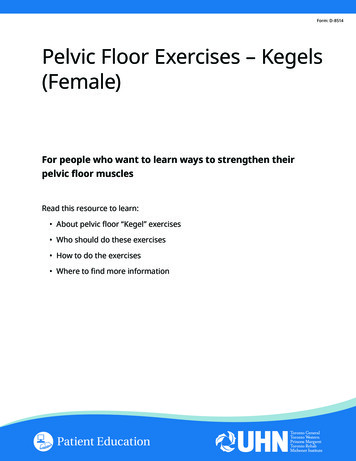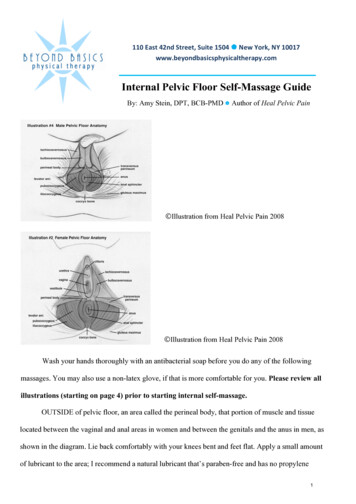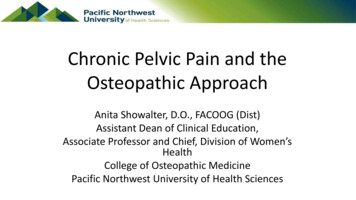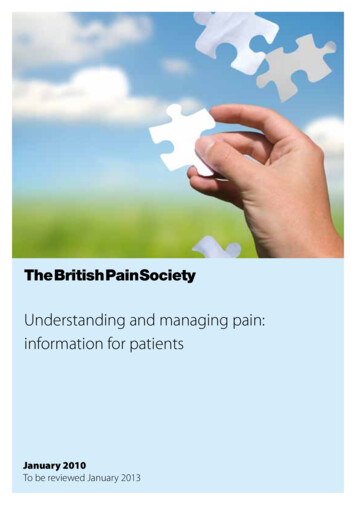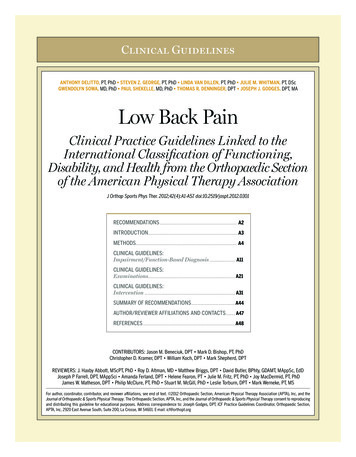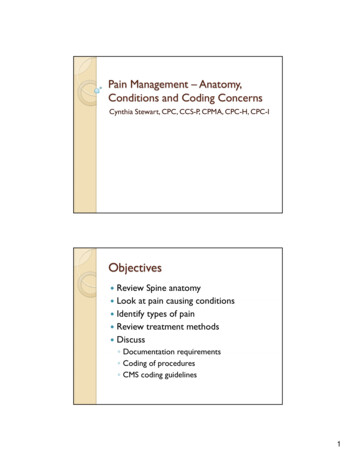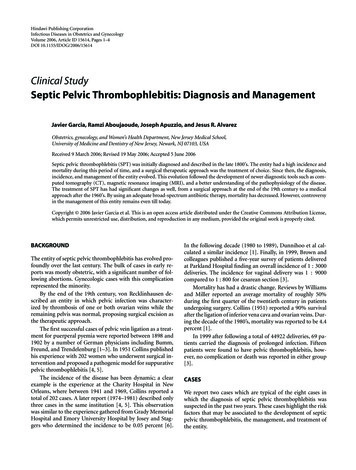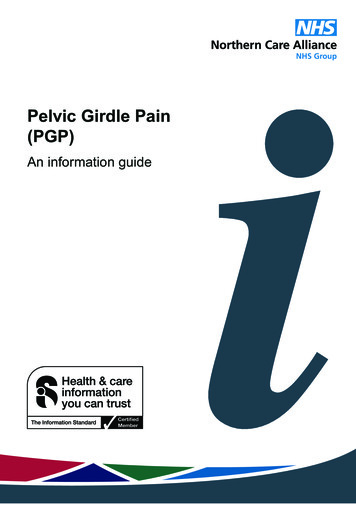
Transcription
Pelvic Girdle Pain(PGP)An information guide
Pelvic Girdle Pain (PGP)This is the term used for all pelvic pain. This includes pain anywherefrom the lumbar spine, abdomen and into the thigh.There are two main causes.These are previous low back pain, and previous PGP. However, itcan occur in the 1st pregnancy.There are lots of contributing factors including: Hormone changesJoints moving unevenlyWeakness of pelvic floor and abdominal muscles prior topregnancyA hard physical job or sedentary lifestyleTwin or more pregnancy.AdviceRest - you may need to rest more often but be as active as the painallows. Tell everybody who deals with you about your conditione.g. midwife, GP.2
During pregnancy If necessary you may be referred to a specialist physiotherapistfor assessment and treatmentYou may need to wear a pelvic support to minimise pelvicdiscomfort. If the pain is severe you may need some help withwalking, e.g. crutches, or advice about pain reliefMinimise non-essential weight bearing activities e.g. shopping,lifting and carrying. Be particularly careful if you have a youngchild - you should avoid carrying them on one hipTo lift correctly, bend your knees; keep your weight evenlydistributed through both legs and your back fairly straight. Tryto keep the load close to your bodySit with your weight evenly distributed through both buttocksand stand with both feet flat on the floor, avoid shifting yourweight to one side. Avoid standing on one leg e.g. to getdressedAvoid straddle movements e.g. in and out of the bath or carand low squattingSleeping on the top of an inside-out sleeping bag or wearing asilky nightdress may make it easier to turn over in bed andsleeping on your side with a pillow between your knees canmake your pelvis more levelConsider alternative positions for intercourse e.g. lying on yourside or kneeling on all foursIf swimming take care getting in and out of the pool andAVOID breast stroke.3
Exercise (Guidelines from The American College of Obstetriciansand Gynaecology)Regular Physical activity: Improves/maintains physical fitnessHelps weight managementReduces the risk of gestational diabetesEnhances psychological well being.30 minutes of moderate intensity exercise (low impact) on mostdays is recommended. It is better to exercise during the day ratherthan the evening due to fatigue and swelling.Stabilising ExercisesIt is important to work the deep supporting muscles around theabdomen and lower back to help stabilise the pelvis and spine. Theywill have to work during different functional activities therefore itis important to practise them in different positions.Sitting - find midway pelvis position Rock pelvis forward all the wayRock pelvis backwards all the wayThen find the midpoint between the two positions andmaintain this for good posture.4
Pelvic floor musclesWhilst maintaining the midpoint position, begin to tighten yourpelvic floor by squeezing around the back passage, as if you aretrying to stop yourself from passing wind, at the same time aslifting the muscles at the front, as if trying to stop a flow of urine.- squeeze for 10 seconds x 10- 10 x short, strong squeezes (do both of these 4 x per day).Lower Abdominal MusclesPlace hands on the lower abdominal muscles creating a diamondshape with hands (belly button in the middle). Draw the tummy away from your hands, to tighten the musclesHold for 10 secs x10, 4x dayTry to do the pelvic floor exercises at the same time. Ifstruggling to do this, do separatelyHold each contraction for up to 10 seconds and relax – thenrepeat up to 10 times.5
Points to WatchYou must keep breathing normally during the exercises – do nothold your breath. If you find this difficult, try to activate the musclesas you breathe out. Try to relax your shoulders and ribcage.If you are lying down ensure you are well supported with pillowsand have your shoulders higher than your hips, or lie on your side. If you are sitting make sure you sit up tall, with your backsupportedIf you are standing have your feet hip distance apart andparallel. Keep your shoulders back and relaxed – imagine thereis a string from your head to your tailbone drawing you up tothe ceiling.Pelvic tiltingThis exercise is a rocking motion of the pelvis forwards andbackwards.This exercise can be done in sitting, standing or on “all fours” (Seepictures below).6
Grow up as tall as you can, arching your lower back and stickingyour bottom outThen, roll back onto your tail bone, tucking your bottom underKeep your upper body as still as possible, the movement shouldcome from the pelvisRepeat x10 several times a day.During labour and delivery Make sure that everybody who deals with you knows aboutyour conditionTry to keep separation of the legs to a minimumAdopt a comfortable position in all stages of labour, e.g. lyingon the left or right side, kneeling upright with support fromcushions or a partner, or standing leaning onto a high bedYou can also use the birthing ball during the first stage, rockingand bouncing gentlyDO NOT place your feet onto your midwife/partner’s hips orshoulders to push as this puts excessive strain onto the pelvisIf your legs need to go into stirrups it is important thatsomeone lifts and lowers them TOGETHER. You should be inthis position for as short a time as possible.It is important to remember these points even if you have anepidural and are not aware of any pain.7
Measuring your pain-free gap You may find it useful to measure your pain-free gap as youapproach labour. Lie on your back, knees bent, feet flatAllow your knees to fall apart gently and measure the distancebetween your knees at which you are no longer comfortableRecord this in your hand held notes and make sure the midwifein the labour suite is aware of your condition.In severe cases caesarean section may need to be considered butthis will have to be discussed with your consultant and there is noevidence to suggest that there are better outcomes than withvaginal deliveries.8
Following the birthYour pain may not resolve immediately after delivery. Give it timeto settle, following the advice previously detailed. If you have hadno improvement six weeks postnatally you may wish to contactyour physiotherapist for advice. Do not be afraid to ask for help. You should get as much rest aspossible – recruit your partner, relatives or friends!If you are still in pain while in hospital ask the doctor for someanti-inflammatory medication and pain killers before goinghomeAvoid heavy lifting and twisting for the first few monthsPremenstrual recurrence is commonly reported so be carefularound this timeIf breast feeding things may take longer to settle.Post Natal Exercises0-6 weeks - you can start pelvic floor exercises and your lowerabdominal exercise as soon as you have started passing urine.Walking and core stability exercises.6-12 weeks - low impact exercise, swimming, gym, power walking,cycling. Progress core stability exercises e.g. Pilates.12 weeks - slowly build up impact.9
You can get further information from the:Pelvic, Obstetric and Gynaecological Physiotherapy (POGP)http:// pogp.csp.org.uk(click on publications and booklets, then leaflets and then you canprint a copy of Pregnancy Related Pelvic Girdle Pain for Mothersto-be and New Mums).There are other useful leaflets to look at too. Pelvic Partnershipwww.pelvicpartnership.org.uk. Tel 01235 820921.10
Notes:11
If English is not your first language and you need help, please contact theInterpretation and Translation ServiceJeśli angielski nie jest twoim pierwszym językiem i potrzebujesz pomocy, skontaktujsię z działem tłumaczeń ustnych i pisemnych ﺑراه ﮐرم ﺗرﺟﻣﺎﻧﯽ اور ﺗرﺟﻣہ ﺧدﻣت ، اﮔر اﻧﮕرﯾزی آپ ﮐﯽ ﭘﮩﻠﯽ زﺑﺎن ﻧﮩﯾں ﮨﮯ اور آپ ﮐو ﻣدد ﮐﯽ ﺿرورت ﮨﮯ ﺗو ﺳﮯ راﺑطہ ﮐرﯾں Dacă engleza nu este prima ta limbă și ai nevoie de ajutor, te rugăm să contacteziServiciul de interpretare și traducereইংরাজী যিদ আপনার .থম ভাষা না হয় এবং আপনার সাহােয9র .েয়াজন হয় তেব অনু হকের ?দাভাষী এবং অনুবাদ পিরেষবা@েত ?যাগােযাগ কBন ﻓﯾرﺟﻰ اﻻﺗﺻﺎل ﺑﺧدﻣﺔ اﻟﺗرﺟﻣﺔ اﻟﺷﻔوﯾﺔ واﻟﺗﺣرﯾرﯾﺔ ، إذا ﻟم ﺗﻛن اﻹﻧﺟﻠﯾزﯾﺔ ھﻲ ﻟﻐﺗك اﻷوﻟﻰ وﺗﺣﺗﺎج إﻟﻰ ﻣﺳﺎﻋدة : 0161 627 8770: interpretation@pat.nhs.ukTo improve our care environment for Patients, Visitors and Staff, Northern CareAlliance NHS Group is Smoke Free including buildings, grounds & car parks.For advice on stopping smoking contact the Specialist Stop Smoking Service on 01706517 522For general enquiries please contact the Patient Advice and Liaison Service(PALS) on 0161 604 5897For enquiries regarding clinic appointments, clinical care and treatment pleasecontact 0161 624 0420 and the Switchboard Operator will put you through tothe correct department / serviceThe Northern Care Alliance NHS Group (NCA) is one of the largest NHS organisationsThe Northern Care Alliance NHS Group (NCA) is one of the largest NHSin the country, employing 17,000 staff and providing a range of hospital and communityorganisations in the country bringing together two NHS Trusts, Salford Royal NHShealthcare services to around 1 million people across Salford, Oldham, Bury, RochdaleFoundation Trust and The Pennine Acute Hospitals NHS Trust.and surrounding areas. Our Care Organisations are responsible for providing our services,deliveringhighoverqualityand reliablecareprovidesto the localcommunitiestheyandserve.TheNCA safe,employs19,000staff anda rangeof hospitalcommunityhealthcareservicesto morethanRoyal1 millionacrossSalford,Oldham,Bury,The NCA bringstogetherSalfordNHSpeopleFoundationTrustand dingareas.Our CareOrganisationsarecommunity Northservicesof The RoyalHospital,FairfieldGeneralHospital in Bury,responsibleforInfirmarydeliveringsafe, highreliablecareto the localand Rochdale(currentlypartqualityof ey hs-groupNorthern Care Alliance NHS Group (NCA) @NCAlliance NHSDate of publication: March 2011Date of review: September 2019Date of next review: September 2021Ref: PI DS 473 The Northern Care Alliance NHS Groupwww.pat.nhs.ukwww.northerncarealliance.nhs.uk
Pelvic Girdle Pain (PGP) This is the term used for all pelvic pain. This includes pain anywhere from the lumbar spine, abdomen and into the thigh. There are two main causes. These are previous low back pain, and previous PGP. However, it can occur in the 1st pregnancy. There are lots of contributing factors including: Hormone changes
